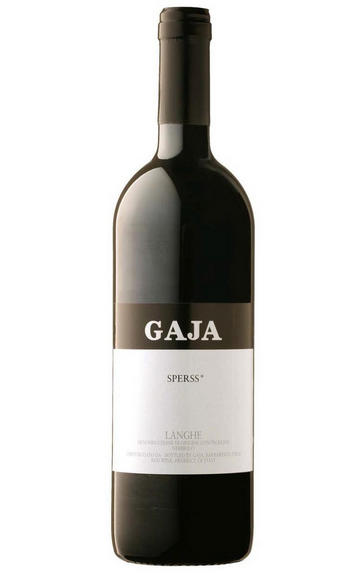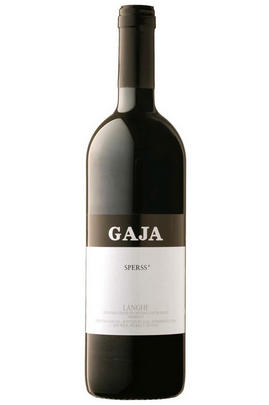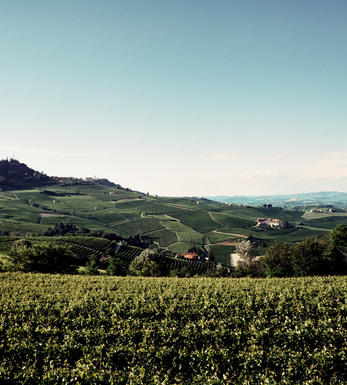
1997 Langhe Nebbiolo, Sperss, Gaja, Piedmont, Italy

Critics reviews
We caught the 1997s from Piedmont at the very summit of their beauty. Gaja's 1997 Sperss is a wine I have enjoyed often over the years, but this bottle was on another level entirely. The stars aligned as the room tasted this spectacular, utterly breathtaking wine. Words alone can't possibly convey the sheer beauty of the 1997 Sperss. Perfect. That's all I can really say.
Antonio Galloni, Vinous.com (February 2012)
A virtually perfect effort is the 1997 Sperss (30,000 bottles), which represents the essence of truffles, earth, and black cherries in its striking aromatics and multidimensional, opulent, full-bodied palate. The acidity seems low because of the huge glycerin levels and prodigious concentration of fruit, but I suspect it is normal in the scheme of oenological measurement. This profound wine requires 3-4 years of cellaring, and should age well for 30-35 years. A genius for sure, Angelo Gaja can not be faulted for what he puts in the bottle. This work of art is worth every cent it will fetch.
Drink 2004 - 2036
Robert M. Parker, Jr., Wine Advocate (June 2001)
Although Sperss today is bottled as a Barolo, from 1996 until 2001, Gaja included around 8% of Barbera in the wine and bottled it as Langhe Rosso. This was a tip of the hat to the traditional bottlings of the region before the introduction of the Barolo and Barbaresco DOCs in the 1960s. 1997 was a very warm vintage in the Langhe, with an early harvest of excellent quality but reduced yields. This vintage character is apparent in the wine, with scents of warm earth, dried fruits and currants. Cool acidity and slightly angular tannins frame dusty, juicy red and black fruits. It's displaying some mulchy notes, with wood and tobacco emerging on a slightly drying finish.
Drink 2023 - 2028
James Button, Decanter.com (October 2023)
Saturated deep ruby. Brooding, rather withdrawn aromas of blackberry, bitter chocolate, espresso and menthol. Dense and huge yet almost magically elegant, thanks to superb vinosity and tannic spine. This monumental wine boasts extraordinary opulence for a Barolo from Serralunga yet gives no impression of excess weight. It has a great lingering, vibrant finish.
Stephen Tanzer, Vinous.com (November 2000)
About this WINE

Gaja
Angelo Gaja is Italy`s most renowned and dynamic wine personality and his impact on wine production in the last 30 years cannot be overestimated.
Angelo Gaja took over the family business in 1970 and, as he says: *The challenge was to maintain the basic power and depth of Nebbiolo while polishing the wines to give them richer colour, fuller fruit, better balance and a more refined style.'
In pursuit of this aim Gaja replanted many of the vineyards, installed temperature-controlled, stainless steel tanks, introduced the concept of ageing wines in small oak barrels and began releasing single vineyard Barbarescos. Most controversial of all, Gaja planted some Cabernet Sauvignon and Chardonnay on prime Barbaresco land.
Today Gaja has 101 hectares of vineyards divided into 32 separate plots and produces around 30,000 cases of wine a year. Gaja produces world-class wines that sell for world-class prices; his latest venture is in Tuscany where he has acquired an estate in Montalcino.

Langhe
Langhe is an all-encompassing zone lying due south of Alba and the River Tanaro in the province of Cuneo. Barolo and Barbaresco both lie within its boundaries.
Langhe is also the name of a regional DOC zone, which is used to classify wines made outside of the traditional Piemontese varietal scheme (Nebbiollo, Barbera, Cortese etc). Chardonnay and Sauvignon Blanc wines from the region are, for example, classified as Langhe DOC.
Langhe Nebbiolo
Effectively the ‘second wine’ of Piedmont’s great Barolo and Barbarescos, the Langhe Nebbiolo DOC is the only way Langhe producers can declassify their Barolo or Barbaresco fruit or wines to make an early-drinking style.
Langhe Nebbiolo can be released onto the market as soon as practicably possible either as a fresh, fruity wine made solely in stainless-steel, or later on having been aged in oak. The Langhe Nebbiolo DOC was created in 1994 along with a plethora of other Langhe DOC wines (so diluting their significance).
Unlike Nebbiolo d’Alba, Langhe Nebbiolo can be cut with 15 percent other red indigenous varieties, such as Barbera or Dolcetto. Leading, quality producers of Barolo and Barbaresco are more inclined to use 100 percent Nebbiolo, recognising its role as a stepping stone, using the fruit from vines that are either too young or poorly situated.
Larger producers tend to use the Langhe Nebbiolo DOC as a valve, declassifying wines destined for Barolo or Barbaresco when the market is difficult. Confusingly Langhe Nebbiolo can also be the declassified wine of Nebbiolo d’Alba.
Recommended producers: Giovanni Rosso di Davide Rosso , Mario Fontana , Ferdinando Principiano

Nebbiolo
Nebbiolo is the grape behind the Barolo and Barbaresco wines and is hardly ever seen outside the confines of Piedmont. It takes its name from "nebbia" which is Italian for fog, a frequent phenomenon in the region.
A notoriously pernickety grape, it requires sheltered south-facing sites and performs best on the well-drained calcareous marls to the north and south of Alba in the DOCG zones of Barbaresco and Barolo.
Langhe Nebbiolo is effectively the ‘second wine’ of Piedmont’s great Barolo & Barbarescos. This DOC is the only way Langhe producers can declassify their Barolo or Barbaresco fruit or wines to make an early-drinking style. Unlike Nebbiolo d’Alba, Langhe Nebbiolo can be cut with 15% other red indigenous varieties, such as Barbera or Dolcetto.
Nebbiolo flowers early and ripens late, so a long hang time, producing high levels of sugar, acidity and tannins; the challenge being to harvest the fruit with these three elements ripe and in balance. The best Barolos and Barbarescos are perfumed with aromas of tar, rose, mint, chocolate, liquorice and truffles. They age brilliantly and the very best need ten years to show at their best.


Buying options
Add to wishlist
Description
Although Sperss today is bottled as a Barolo, from 1996 until 2001, Gaja included around 8% of Barbera in the wine and bottled it as Langhe Rosso. This was a tip of the hat to the traditional bottlings of the region before the introduction of the Barolo and Barbaresco DOCs in the 1960s. 1997 was a very warm vintage in the Langhe, with an early harvest of excellent quality but reduced yields. This vintage character is apparent in the wine, with scents of warm earth, dried fruits and currants. Cool acidity and slightly angular tannins frame dusty, juicy red and black fruits. It's displaying some mulchy notes, with wood and tobacco emerging on a slightly drying finish.
Drink 2023 - 2028
James Button, Decanter.com (October 2023)
wine at a glance
Delivery and quality guarantee